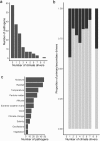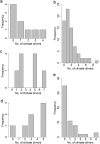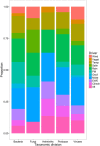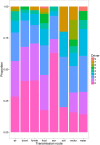Systematic Assessment of the Climate Sensitivity of Important Human and Domestic Animals Pathogens in Europe
- PMID: 28769039
- PMCID: PMC5541049
- DOI: 10.1038/s41598-017-06948-9
Systematic Assessment of the Climate Sensitivity of Important Human and Domestic Animals Pathogens in Europe
Erratum in
-
Author Correction: Systematic Assessment of the Climate Sensitivity of Important Human and Domestic Animals Pathogens in Europe.Sci Rep. 2018 Apr 25;8(1):6773. doi: 10.1038/s41598-018-24606-6. Sci Rep. 2018. PMID: 29691428 Free PMC article.
Abstract
Climate change is expected to threaten human health and well-being via its effects on climate-sensitive infectious diseases, potentially changing their spatial distributions, affecting annual/seasonal cycles, or altering disease incidence and severity. Climate sensitivity of pathogens is a key indicator that diseases might respond to climate change, but the proportion of pathogens that is climate-sensitive, and their characteristics, are not known. The climate sensitivity of European human and domestic animal infectious pathogens, and the characteristics associated with sensitivity, were assessed systematically in terms of selection of pathogens and choice of literature reviewed. Sixty-three percent (N = 157) of pathogens were climate sensitive; 82% to primary drivers such as rainfall and temperature. Protozoa and helminths, vector-borne, foodborne, soilborne and waterborne transmission routes were associated with larger numbers of climate drivers. Zoonotic pathogens were more climate sensitive than human- or animal-only pathogens. Thirty-seven percent of disability-adjusted-life-years arise from human infectious diseases that are sensitive to primary climate drivers. These results help prioritize surveillance for pathogens that may respond to climate change. Although this study identifies a high degree of climate sensitivity among important pathogens, their response to climate change will be dependent on the nature of their association with climate drivers and impacts of other drivers.
Conflict of interest statement
The authors declare that they have no competing interests.
Figures




References
-
- Baylis, M. & Morse, A. P. In The SAGE Handbook of Environmental Change (ed JA Matthews) (Sage, 2012).
-
- Purse BV, et al. Incriminating bluetongue virus vectors with climate envelope models. J. Appl. Ecol. 2007;44:1231–1242. doi: 10.1111/j.1365-2664.2007.01342.x. - DOI
-
- Schroder W, Schmidt G. Spatial modelling of the potential temperature-dependent transmission of vector-associated diseases in the face of climate change: main results and recommendations from a pilot study in Lower Saxony (Germany) Parasitol. Res. 2008;103:S55–S63. doi: 10.1007/s00436-008-1051-z. - DOI - PubMed
Publication types
LinkOut - more resources
Full Text Sources
Other Literature Sources

